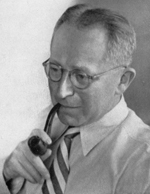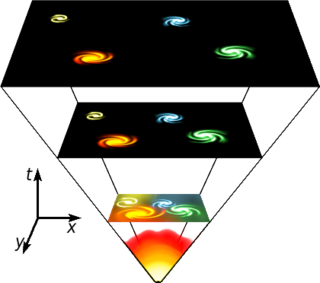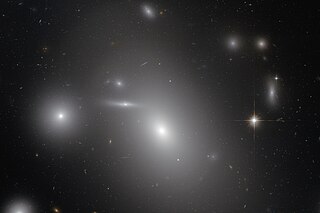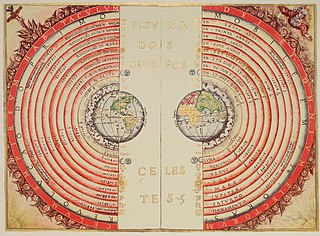
Edwin Powell Hubble was an American astronomer. He played a crucial role in establishing the fields of extragalactic astronomy and observational cosmology.

A galaxy is a system of stars, stellar remnants, interstellar gas, dust, and dark matter bound together by gravity. The word is derived from the Greek galaxias (γαλαξίας), literally 'milky', a reference to the Milky Way galaxy that contains the Solar System. Galaxies, averaging an estimated 100 billion stars, range in size from dwarfs with less than a hundred million stars, to the largest galaxies known – supergiants with one hundred trillion stars, each orbiting its galaxy's center of mass. Most of the mass in a typical galaxy is in the form of dark matter, with only a few percent of that mass visible in the form of stars and nebulae. Supermassive black holes are a common feature at the centres of galaxies.

A nebula is a distinct luminescent part of interstellar medium, which can consist of ionized, neutral, or molecular hydrogen and also cosmic dust. Nebulae are often star-forming regions, such as in the "Pillars of Creation" in the Eagle Nebula. In these regions, the formations of gas, dust, and other materials "clump" together to form denser regions, which attract further matter and eventually become dense enough to form stars. The remaining material is then thought to form planets and other planetary system objects.

Frederick William Herschel was a German-British astronomer and composer. He frequently collaborated with his younger sister and fellow astronomer Caroline Herschel. Born in the Electorate of Hanover, William Herschel followed his father into the military band of Hanover, before emigrating to Great Britain in 1757 at the age of nineteen.
The following is a timeline of galaxies, clusters of galaxies, and large-scale structure of the universe.
This timeline of cosmological theories and discoveries is a chronological record of the development of humanity's understanding of the cosmos over the last two-plus millennia. Modern cosmological ideas follow the development of the scientific discipline of physical cosmology.

Johann Heinrich Lambert was a polymath from the Republic of Mulhouse, generally identified as either Swiss or French, who made important contributions to the subjects of mathematics, physics, philosophy, astronomy and map projections.

William Parsons, 3rd Earl of Rosse, was an Anglo-Irish astronomer, naturalist, and engineer. He was president of the Royal Society (UK), the most important association of naturalists in the world in the nineteenth century. He built several giant telescopes. His 72-inch telescope, built in 1845 and colloquially known as the "Leviathan of Parsonstown", was the world's largest telescope, in terms of aperture size, until the early 20th century. From April 1807 until February 1841, he was styled as Baron Oxmantown.

Adriaan van Maanen was a Dutch–American astronomer. Born in Friesland, he studied astronomy at the University of Utrecht, earning his Ph.D. in 1911, and worked briefly at the University of Groningen. In 1911, he came to the United States to work as a volunteer in an unpaid capacity at Yerkes Observatory. Within a year he got a position at the Mount Wilson Observatory, where he remained active until his death in 1946.
Tired light is a class of hypothetical redshift mechanisms that was proposed as an alternative explanation for the redshift-distance relationship. These models have been proposed as alternatives to the models that involve the expansion of the universe. The concept was first proposed in 1929 by Fritz Zwicky, who suggested that if photons lost energy over time through collisions with other particles in a regular way, the more distant objects would appear redder than more nearby ones.

The Great Debate, also called the Shapley–Curtis Debate, was held on 26 April 1920 at the Smithsonian Museum of Natural History, between the astronomers Harlow Shapley and Heber Curtis. It concerned the nature of so-called spiral nebulae and the size of the universe. Shapley believed that these nebulae were relatively small and lay within the outskirts of the Milky Way galaxy, while Curtis held that they were in fact independent galaxies, implying that they were exceedingly large and distant.

Byers Green is a village and former civil parish, now in the parish of Spennymoor, in the County Durham district, in the ceremonial county of Durham, England. It is situated to the north of Bishop Auckland, between Willington and Spennymoor, and a short distance from the River Wear. It has a population of 672.

Cosmology is a branch of physics and metaphysics dealing with the nature of the universe, the cosmos. The term cosmology was first used in English in 1656 in Thomas Blount's Glossographia, and in 1731 taken up in Latin by German philosopher Christian Wolff, in Cosmologia Generalis. Religious or mythological cosmology is a body of beliefs based on mythological, religious, and esoteric literature and traditions of creation myths and eschatology. In the science of astronomy, cosmology is concerned with the study of the chronology of the universe.

The Milky Way is the galaxy that includes the Solar System, with the name describing the galaxy's appearance from Earth: a hazy band of light seen in the night sky formed from stars that cannot be individually distinguished by the naked eye. The term Milky Way is a translation of the Latin via lactea, from the Greek γαλαξίας κύκλος, meaning "milky circle". From Earth, the Milky Way appears as a band because its disk-shaped structure is viewed from within. Galileo Galilei first resolved the band of light into individual stars with his telescope in 1610. Until the early 1920s, most astronomers thought that the Milky Way contained all the stars in the Universe. Following the 1920 Great Debate between the astronomers Harlow Shapley and Heber Doust Curtis, observations by Edwin Hubble showed that the Milky Way is just one of many galaxies.

The history of the Big Bang theory began with the Big Bang's development from observations and theoretical considerations. Much of the theoretical work in cosmology now involves extensions and refinements to the basic Big Bang model. The theory itself was originally formalised by Father Georges Lemaître in 1927. Hubble's Law of the expansion of the universe provided foundational support for the theory.

Universal Natural History and Theory of the Heavens, subtitled or an Attempt to Account for the Constitutional and Mechanical Origin of the Universe upon Newtonian Principles, is a work written and published anonymously by Immanuel Kant in 1755.
In astronomy, galactocentrism is the theory that the Milky Way Galaxy, home of Earth's Solar System, is at or near the center of the Universe.

NGC 4889 is an E4 supergiant elliptical galaxy. It was discovered in 1785 by the British astronomer Frederick William Herschel I, who catalogued it as a bright, nebulous patch. The brightest galaxy within the northern Coma Cluster, it is located at a median distance of 94 million parsecs from Earth. At the core of the galaxy is a supermassive black hole that heats the intracluster medium through the action of friction from infalling gases and dust. The gamma ray bursts from the galaxy extend out to several million light years of the cluster.

The center of the Universe is a concept that lacks a coherent definition in modern astronomy; according to standard cosmological theories on the shape of the universe, it has no center.

NGC 5053 is the New General Catalogue designation for a globular cluster in the northern constellation of Coma Berenices. It was discovered by German-British astronomer William Herschel on March 14, 1784 and cataloged as VI-7. In his abbreviated notation, he described it as, "an extremely faint cluster of extremely small stars with resolvable nebula 8 or 10′ diameter, verified by a power of 240, beyond doubt". Danish-Irish astronomer John Louis Emil Dreyer reported in 1888 that the cluster appeared, "very faint, pretty large, irregular round shape, growing very gradually brighter at the middle".


















